All photos by Old Naturalist
Download the Winter Birds response sheet. Answer the questions using the text below.
Click here for the Winter Birds PDF.
Not all northern birds migrate south for the winter. A few birds eliminate the dangers of migration and take their chances with the weather and their ability to find food in the frozen northern climate. Since food is at a premium in the winter, you can easily attract birds to you home by putting out a feeder. My feeder is 20 feet from the house and birds have been readily coming to it all winter. I have two feeders: thistle feeder for goldfinches and a covered feeding station which has a suet feeder attached to it. I feed black sunflower seed only, because it is cheap and numerous species eat the seed.
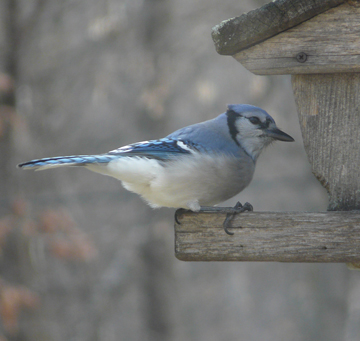
Blue jay
Most blue jays remain in Minnesota through the winter. However, some young birds migrate south in the fall. Jays can be easily told by the bluish color and the crest on their head. At the feeder, blue jays eat sunflower seeds and cracked corn. They will imitate the scream of a hawk to scare other birds away from the feeder. Blue jays can store a number of seeds or acorns in their gular pouch (part of their throat). Also, they store nuts in the hollows of trees and eat them later.
In March, blue jays begin singing their spring “pumphandle” song. Also, in early spring blue jays tend to flock together, calling “Jay, jay, jay” repeatedly. To hear the pumphandle call and other winter/spring birds go to: http://oldnaturalist.com/the-sounds-of-spring/
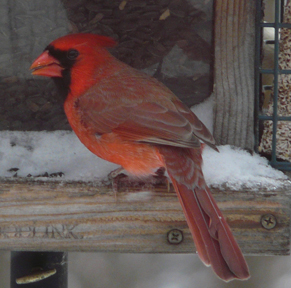
Male cardinal
The male cardinal can be told by its red color, black mask, and crest on its head. The back of this bird is a grayish red. The beak of the cardinal is orange and thick for cracking seeds. Cardinals will readily come to the feeder if sunflower seeds are available. In early February, male and female cardinals begin singing their spring calls, and establishing territories. In December and January, cardinals are not territorial and can be seen in small flocks of up to 20 birds. On cold winter days, cardinals seek protection in evergreen trees.
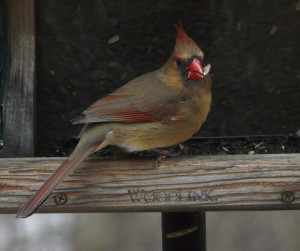
Female cardinal
The white-breasted nuthatch is a small grayish-blue forest bird. Nuthatches are often seen upside-down on trees and have been called the “upside-down bird”. This behavior helps them see eggs and wintering insects. A nuthatch uses its strong beak to dig out insect eggs found under tree bark. Male and female nuthatches maintain a feeding territory all year long. In late winter, nuthatches start setting up their nesting territories which are usually in the same area as their feeding territory. In February, males can be heard calling in the woods. The spring call of the nuthatch is a nasal “eee-eee-eee” (to hear a nuthatch call and other winter/spring birds go to: http://oldnaturalist.com/the-sounds-of-spring/
Nuthatches eat sunflower seeds, suet and corn and readily come to a bird feeder.
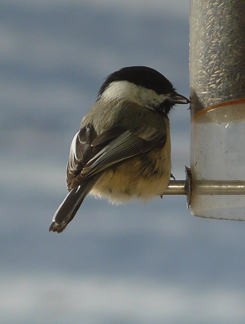
Chickadee
The chickadee is a favorite of many birdwatchers. It is a small bird and has a black cap and black bib. Chickadees are found in small flocks which remain in contact by singing “chick-a-dee-dee… chick-a-dee-dee”. When they are not at a feeder, chickadees search for insects or eggs on twigs and outer branches. At night, chickadees may sleep in a tree hole made by woodpeckers or they may roost in a small flock in an evergreen tree. In early February, chickadee flocks break up when they begin to select their mates. By mid February they begin singing their spring call, “Feebee…Feebee”. It is welcome sound during a long winter.
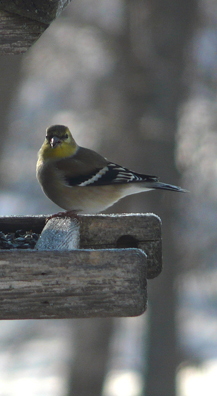
Goldfinch in winter plumage
Most goldfinch remain in Minnesota through the winter. But if food is scarce, they may migrate south in small flocks.
Goldfinch change color in the winter from a bright yellow summer plumage to a drab greenish-yellow color. The wing bars remain throughout the year. They are often seen in flocks of 8-10 birds at feeders. Goldfinch readily come to thistle feeders.
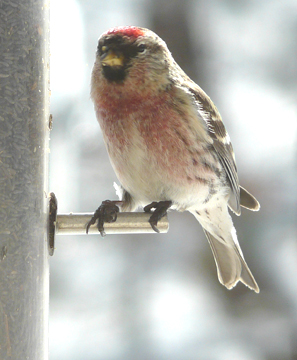
Male red poll
Redpolls do not migrate to the Twin Cities every year, but some winters they invade Minnesota in large numbers. The winter of 2009 was a “redpoll invasion year”. Redpolls are usually seen in small flocks and feed on grass seed and weed seeds. In spring, Redpolls migrate to the Canadian tundra to nest.

Junco
Juncos are one of the few birds that migrate to Minnesota in the winter. They migrate from Canada and tend to return to the same wintering area each year. They are usually seen in small flocks and feed on seeds on the ground. Juncos tend to roost in the same evergreen trees each night. They usually leave Minnesota in March and migrate north to nest. Juncos are one of the most common birds in North America with a total population estimate of over 500 million birds.

Pileated woodpecker
Pileated woodpeckers are the largest woodpeckers in North America. They are about the size of a crow. Pileated woodpeckers live deep in the woods, but will visit backyard suet feeders. In February, they start setting up their mating territories and the loud spring call can be heard, “Kek-Kek-Kek-Kek-Kek-Kek”, echoing throughout the forest. A Pileated “drums” on trees to announce its territory. The sound is very loud and resembles an actual drum beating in the woods.
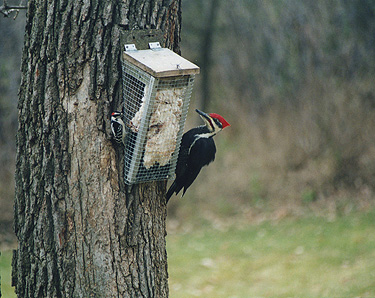
Downy and Pileated Woodpeckers
In Minnesota, the pileated woodpecker is commonly seen. However, in most parts of the United States, they are rare. Pileated woodpeckers eat carpenter ants. They search for the ants in diseased trees and cut large furrows deep in the wood. In fact, some trees are so “carved up” by pileated woodpeckers that they resemble wood sculptures in the forest.
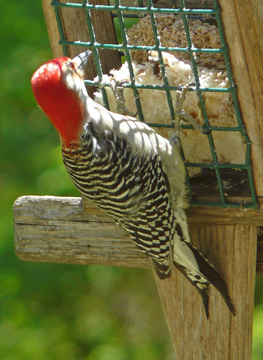
Red bellied woodpecker
The red-bellied woodpecker can be told by its black and white ladder-back and the flaming red crown on the male’s head. The breast of a red-bellied woodpecker is tan and not red. Like most woodpeckers, they readily come to suet feeders.
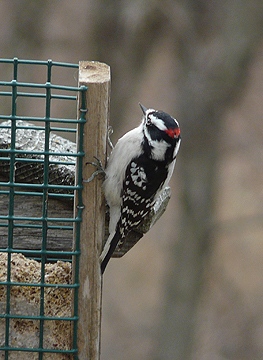
Male downy woodpecker
The downy woodpecker is the smallest woodpecker in our northern woods. They are slightly larger than a chickadee. The male has a red spot on the back of the head and the female doesn’t. Downy woodpeckers can be heard “drumming” in March. The sound resembles someone tapping rapidly on a tree. Downy woodpeckers will peck on a diseased tree over the winter, feeding on insect larvae and eggs.
The hairy woodpecker looks identical to the downy, but it is almost twice the size.
Do you want to keep track of winter birds you see in your neighborhood! You can print it out from the website (smaller size) or download a full-sized PDF. Click here for the Winter Birds PDF.
Illustrations by Amelia Ladd
Copyright Nature Seeker Workbook, April 2013.

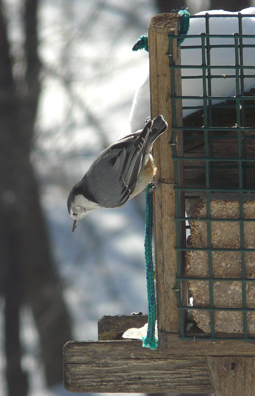
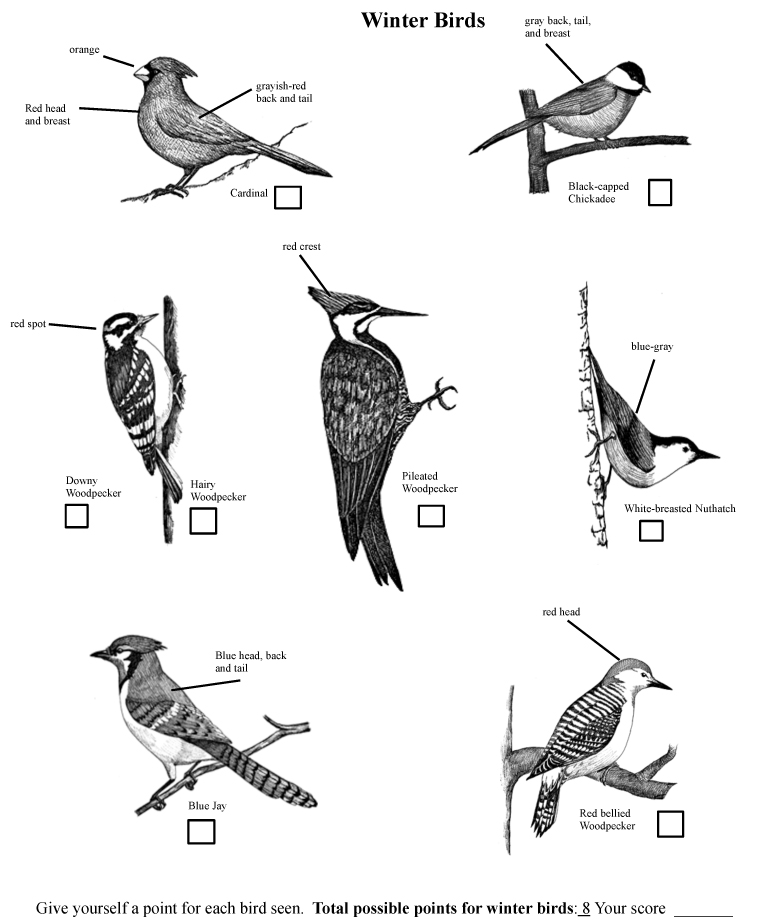



it may be hard to imagine much of anything to eat for birds among our bleak landscape this time of year in our region besides seed in the feeders, but curiously, there is in fact caterpillars to be had at this time of year on the branches of trees. University of Delaware Professor Douglas Tallamy states in his latest installment “Nature of Oaks” (Timber Press, 2022) that he and other naturalist have found fresh caterpillar remains in a variety of different birds in northern climates. not all trees are equal in their insect interactions however, it is the mature native trees that support the most biodiversity. Arbornaut Meg “Her Highness” Lowman describes the value of these trees akin to the Louvre and rightly argues that we must not only plant more of them but preserve the most veteran among us. i argue that we should honor this in an arboreal AND humanistic endeavors. go forth my friends and hug not only a big oak tree but a Veteran service member of our armed forces and academia and healthcare. the last few years in particular have been especially hard on them. most of all, please be extra patient and sensitive to everyone right now, because we all could use a little extra seed to sow a bit more hope, peace and love on. 🙂
Thank you always for your education. I have a view of an evergreen out my office window and I never new how many small birds and nests are hidden in the branches.
We’re not allowed to have feeders at Regency Woods. I do have juncos hop around on the balcony. They pick up something from the outdoor carpet that blows in from the marsh. Cattail seeds possibly? Chickadees just stop in to say “hi.”
Looking for information on owls in this area. I heard that they are looking to nest early
this year. True? Any data will be mostly gratefully received. mfg